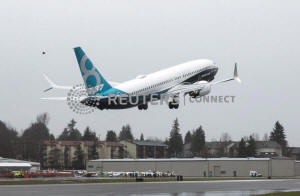|
Regulators knew before crashes that 737
MAX trim control was confusing in some conditions: document
 Send a link to a friend
Send a link to a friend
 [March 29, 2019]
By Jamie Freed [March 29, 2019]
By Jamie Freed
SINGAPORE (Reuters) - U.S. and European
regulators knew at least two years before a Lion Air crash that the
usual method for controlling the Boeing 737 MAX's nose angle might not
work in conditions similar to those in two recent disasters, a document
shows.
The European Aviation and Space Agency (EASA) certified the plane as
safe in part because it said additional procedures and training would
"clearly explain" to pilots the "unusual" situations in which they would
need to manipulate a rarely used manual wheel to control, or "trim," the
plane's angle.
Those situations, however, were not listed in the flight manual,
according to a copy from American Airlines seen by Reuters.
The undated EASA certification document, available online, was issued in
February 2016, an agency spokesman said.

It specifically noted that at speeds greater than 230 knots (265mph,
425kph) with flaps retracted, pilots might have to use the wheel in the
cockpit's center console rather than an electric thumb switch on the
control yoke.
EASA and the U.S. Federal Aviation Administration (FAA) ultimately
determined that set-up was safe enough for the plane to be certified,
with the European agency citing training plans and the relative rarity
of conditions requiring the trim wheel.
In the deadly Lion Air crash in October, the pilots lost control after
initially countering the Maneuvering Characteristics Augmentation System
(MCAS), a new automated anti-stall feature that was pushing the nose
down based on data from a faulty sensor, according to a preliminary
report from Indonesian investigators released in November.
The flight conditions were similar to those described in the EASA
document, a source at Lion Air said. The source said that training
materials before the crash did not say the wheel could be required under
those conditions but that Boeing advised the airline about it after the
crash.
Boeing declined to comment on the EASA document or its advice to Lion
Air, citing the ongoing investigation into the crash.
Ethiopia's Transport Ministry, France's BEA air accident authority and
the FAA have all pointed to similarities between the Lion Air crash and
an Ethiopian Airlines disaster this month. But safety officials stress
that the Ethiopian investigation is at an early stage.
'NOT PHYSICALLY EASY'
The crashes have also heightened scrutiny of the certification and pilot
training for the latest model of Boeing Co's best-selling workhorse
narrowbody, now grounded globally.
In the EASA document, the regulator said simulations showed the electric
thumb switches could not keep the 737 MAX properly trimmed under certain
conditions, including those of the Lion Air and Ethiopian Airlines
crashes, according to the Indonesian preliminary report and a source
with knowledge of the Ethiopian air traffic control recordings.

The trim system adjusts the angle of the nose. If the nose is too far
up, the jet risks entering a stall.
Additional procedures and training needed to "clearly explain" when the
manual wheel might be needed, according to the document. The EASA
spokesman said that was a reference to the Boeing flight crew operations
manual.
An American Airlines Group Inc flight manual for 737 MAX pilots dated
October 2017 said the thumb switches had less ability to move the nose
than the manual wheel.
The manual, which is 1,400 pages long, did not specify the flight
conditions in which the wheel might be needed.
The trim wheel is a relic of the Boeing 737's 1960s origins and does not
appear in more modern planes like the 787 and Airbus SE A350. It is not
often used, several current and former 737 pilots told Reuters.
"It would be very unusual to use the trim wheel in flight. I have only
used manual trim once in the simulator," said a 737 pilot. "It is not
physically easy to make large trim changes to correct, say, an MCAS
input. You - or more than likely the other pilot - have to flip out a
little handle and wind, much like a boat winch."
[to top of second column]
|

A Boeing 737 MAX 8 takes off during a flight test in Renton,
Washington, January 29, 2016. REUTERS/Jason Redmond/File Photo

The EASA document said that after flight testing, the FAA's
Transport Airplane Directorate, which oversees design approvals and
modifications, was concerned about whether the 737 MAX system
complied with regulations because the thumb switches could not
control trim on their own in all conditions.
FAA declined to comment on the European document. A trim-related
"equivalent level of safety" (ELOS) memorandum listed in its 737 MAX
certification document is not available on the FAA website. The
agency declined to provide it to Reuters.
CONFUSING SIGNALS
The night before the Lion Air crash, different pilots on the same
plane faced a similar problem with MCAS and tried to use electric
trim to counteract it, according to the preliminary report from
Indonesian investigators.
After the third time MCAS forced the nose down, the first officer
commented that the control column was "too heavy to hold back" to
counter the automated movements, the preliminary report said.
Former FAA accident investigator Mike Daniel said that to prevent
stalls, the control column was designed to require more force for a
pilot to pull back than to push forward.
Boeing on Wednesday said software changes to MCAS would provide
additional layers of protection, including making it impossible for
the system to keep the flight crew from counteracting it.

On the 737 MAX, Boeing removed the "yoke jerk" function that enabled
pilots to disable the automated trim system with a hard pull on the
control column rather than hitting two cut-out switches on the
center console.
In a blog post on his personal website, former Boeing engineer Peter
Lemme said that could make things harder for a pilot in a crisis.
"In the scenario where the stabilizer is running away nose down, the
pilot may only fixate on pulling the column back in response," he
said. "They may not be mentally capable to trim back or cutout the
trim - instead they just keep pulling."
Ultimately the crew the evening before the Lion Air crash stopped
the automated nose-down movement with the cut-out switches and used
the wheel to control trim for the remainder of the flight, the
preliminary report said.
That was the proper procedure to deal with a runaway stabilizer,
according to Boeing.
However, current and former pilots told Reuters that the way the
trim wheel and other controls behaved in practice compared with in
training may have confused the Lion Air crews, who were also dealing
with warnings about unreliable airspeed and altitude.
"MCAS activation produces conditions similar to a runaway trim, but
the training is not done with a stick shaker active and multiple
other failures, which make the diagnosis much more difficult," said
John Cox, an aviation safety consultant and former commercial pilot.
The stick shaker alerts pilots to a potential stall by vibrating the
control column.
Reuters this month reported that an off-duty pilot in the cockpit on
the night before the Lion Air crash spotted the runaway stabilizer
problem, according to two sources familiar with the matter.
Boeing on Wednesday said changes to the MCAS software would help
"reduce the crew's workload in non-normal flight situations."
(Reporting by Jamie Freed in Singapore; additional reporting by
Allison Lampert in Montreal, Cindy Silviana in Jakarta, David
Shepardson in Washington, Marcelo Rochabrun in Sao Paolo, Eric M.
Johnson in Seattle, Tim Hepher in Paris, Tracy Rucinski in Chicago
and Maggie Fick in Nairobi; Editing by Gerry Doyle)
[© 2019 Thomson Reuters. All rights
reserved.]
Copyright 2019 Reuters. All rights reserved. This material may not be published,
broadcast, rewritten or redistributed.
Thompson Reuters is solely responsible for this content.
 |